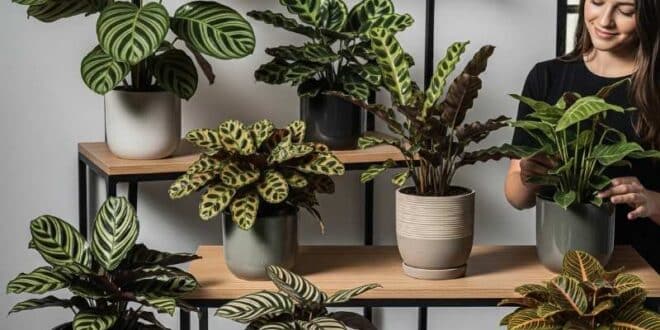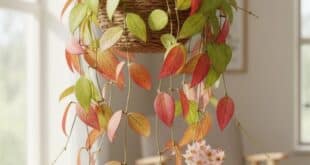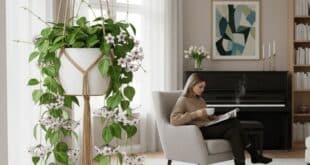Calathea Plant
Imagine a plant with leaves so incredibly patterned and vibrantly colored, they look like they were hand-painted by nature itself! And here’s the magic trick: its leaves actually move, folding upwards at night as if in prayer, and then unfurling again with the morning light. That’s the breathtaking Calathea plant! These captivating beauties (Calathea is the genus, though some are now reclassified as Goeppertia) are absolute showstoppers in the houseplant world.
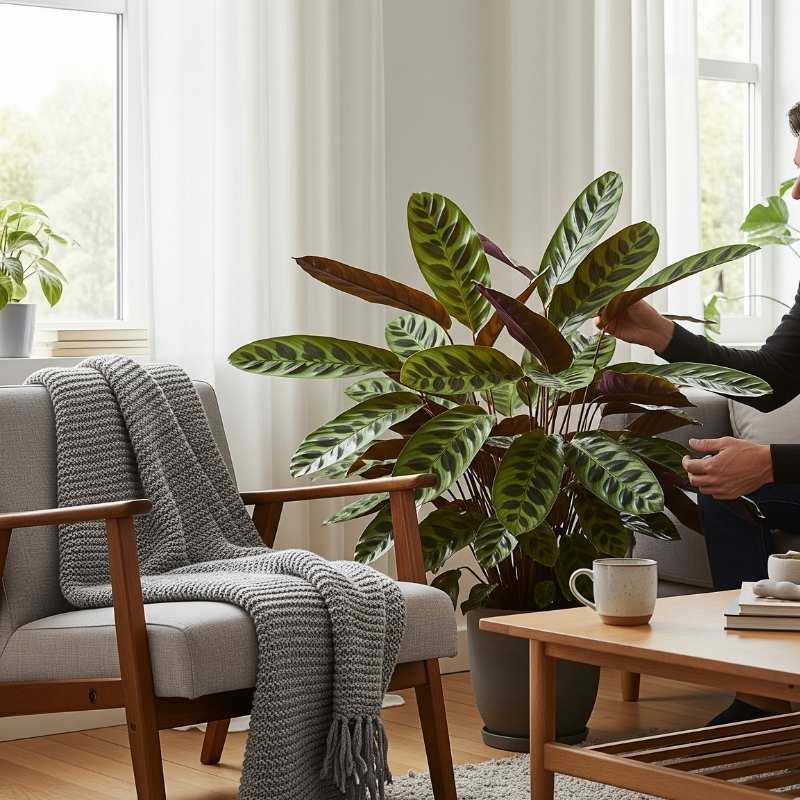
Originating in the lush, tropical rainforests of Central and South America, Calatheas add a unique blend of exotic charm and natural artistry to any environment. While they have a reputation for being a bit “fussy,” their sheer beauty and unique movement make them incredibly rewarding plants for those who love a delightful challenge! Ready to discover the secrets to keeping these dancing wonders thriving? Let’s explore how to make your Calathea truly sparkle!
What Makes a Calathea Plant So Unique? Nature’s Painted Leaves and Dancing Foliage
When you look at a Calathea, its leaves are undeniably the main event! They come in an astonishing variety of shapes – from broad ovals to elongated forms – but it’s their stunning patterns and vibrant colors that truly mesmerize. You’ll find intricate stripes, bold spots, feathered designs, and striking veins in shades of green, pink, red, silver, and even yellow. What’s even cooler? The undersides of their leaves are often a rich purple, burgundy, or red, adding another layer of visual delight as they move.
And yes, they move! This unique daily dance is called nyctinasty. As dusk settles, their leaves slowly fold upwards, resembling hands clasped in prayer (which is why they’re sometimes called “Prayer Plants,” just like Maranta). Then, with the first light of dawn, they gracefully flatten out again. It’s a truly captivating show that happens every single day!
💡 Great spot for an image! You could add a beautiful, close-up photo here showcasing a Calathea’s intricate leaf patterns, maybe even showing the colorful underside.
Where Do Calathea Plants Come From? South America’s Humid Understory
Your Calathea’s ancestors come directly from the warm, extremely humid, and shady forest floors of tropical Central and South America, particularly from places like Brazil and Colombia. In their natural habitat, they thrive beneath the dense canopy of taller trees, enjoying filtered light and constant, high humidity. Understanding these rainforest roots is key to giving your Calathea the best possible care indoors – they crave warmth and moisture!
What Are Its Other Names? “Prayer Plant” and Its Artistic Allure
Calatheas have many nicknames that hint at their amazing patterns! You’ll often hear them called “Zebra Plant,” “Peacock Plant,” or “Rattlesnake Plant” because their leaves resemble these animals’ markings. As mentioned, they’re also sometimes called “Prayer Plants” due to their nightly leaf movement, though true Prayer Plants usually refer to the Maranta genus. Their unique artistry and captivating movement give them an irresistible allure.
What Kinds of Calathea Plants Are There?
The world of Calatheas is a vast and stunning art gallery! There are hundreds of species and countless cultivars, each with its own unique leaf design.
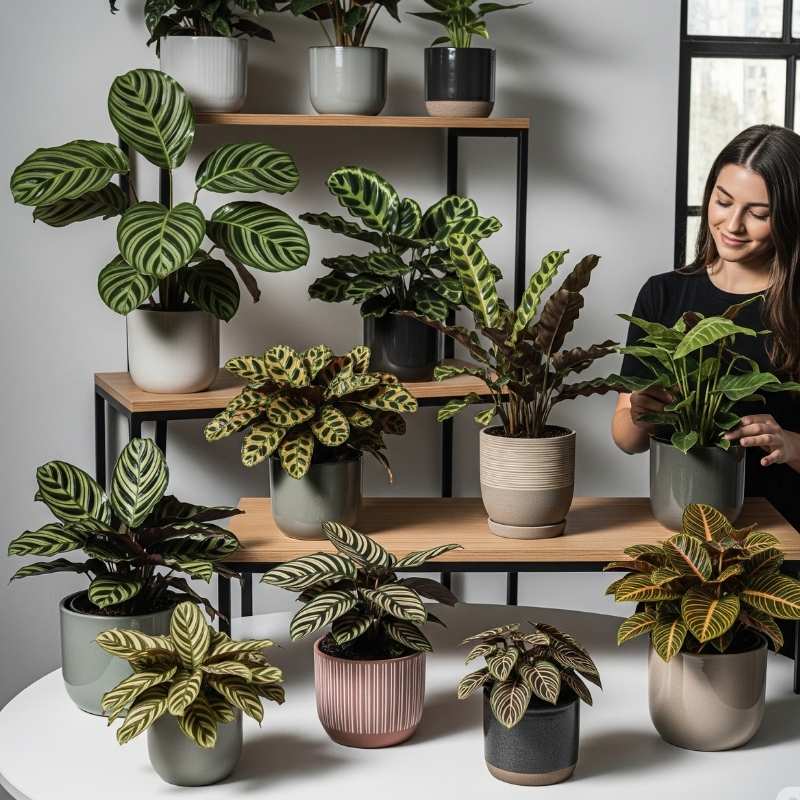
Popular Calathea Varieties: A Gallery of Living Art
Here are some common and highly sought-after types of Calathea, each a masterpiece in itself:
| Type of Calathea | Key Features | Leaf Look | Looks Like… |
| Calathea orbifolia | Large, round leaves with stunning, bold silver stripes. Very elegant. | Big, round, light green with prominent dark green veins/stripes. | A sophisticated, round, striped artwork. |
| Calathea makoyana | Commonly referred to as the Peacock Plant, it features delicate oval-shaped leaves adorned with dark green patterns and rich purple undersides. | Green leaves with darker green “eye” patterns, purple underside. | A peacock’s tail feather, wonderfully intricate. |
| Calathea lancifolia | Rattlesnake Plant. Long, wavy-edged leaves with alternating dark green spots, vivid purple underside. | Narrow, elongated, wavy leaves with distinctive dark spots between veins. | Resembles a snake’s rattle or skin. |
| Calathea zebrina | Zebra Plant. Large, velvety leaves with bold, fuzzy dark green stripes on a lighter green background. | Velvety, with distinct dark green stripes resembling zebra stripes. | A lush, velvet striped masterpiece. |
| Calathea ornata | Pinstripe Calathea. Dark green leaves with delicate pink or white pinstripes. | Dark green with thin, contrasting pink or white lines. | Elegant, hand-painted pinstripes. |
| Calathea medallion | Broad, round leaves with a vibrant green, pink, and red pattern on top, and a deep purple underside. | Bold patterns of green, cream, and pink/red; rich purple underside. | A colorful, abstract medallion. |
💡 Great spot for an image! You could add a stunning collage here showing the distinct patterns and colors of different Calathea types like orbifolia, makoyana, and lancifolia.
Leaf Looks: Colors, Patterns, and Textures
The leaves are truly the soul of the Calathea! You’ll find an endless array of color combinations, from intricate greens, pinks, and silvers on top to those amazing vibrant purple or reddish undersides. The patterns are equally diverse: crisp stripes, bold spots, feathered designs, or delicate pinstripes. And the textures! Some leaves are smooth and glossy, others are wonderfully velvety, and some even have a corrugated, ribbed feel. It’s a true sensory delight!
Growth Habit: Bushy and Clumping
Calatheas generally grow as compact, bushy, upright plants. Their leaves emerge directly from the soil, forming a dense mound of vibrant foliage. They create a lush, full appearance, making them perfect for tabletops, decorative planters, or as stunning floor accents.
How Do You Take Care of Your Calathea Plant?
Calatheas have a reputation for being somewhat temperamental, but don’t let that intimidate you! They just have specific preferences. Once you learn their language, they’re incredibly rewarding! The key is mimicking their cool, humid rainforest home.
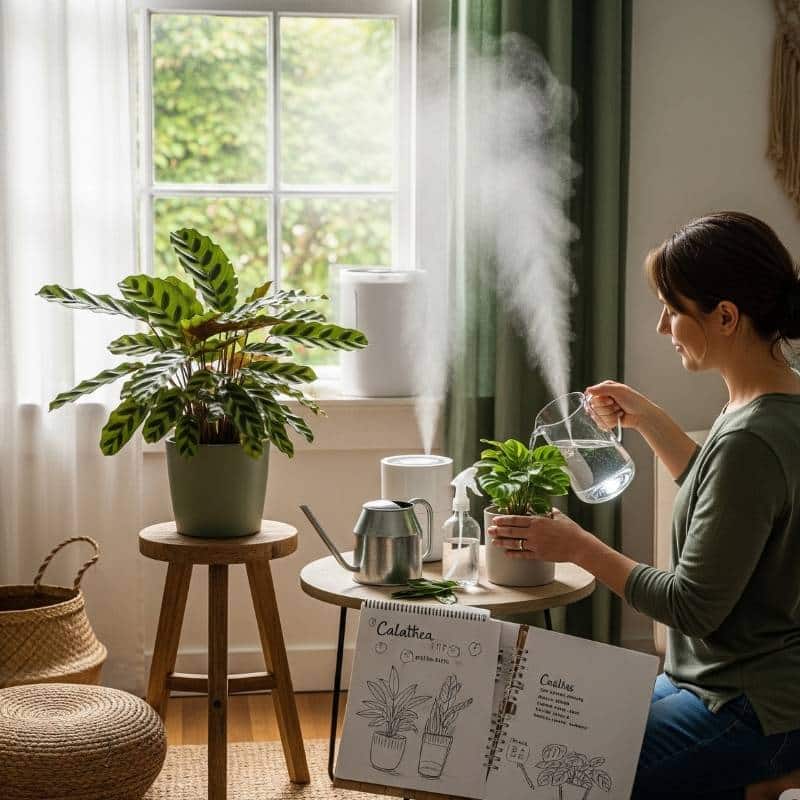
Calathea Plant Care Summary
Here’s a quick overview of what your Calathea loves:
| Care Category | What Your Calathea Needs |
| Light | Bright, indirect light (essential for vibrant patterns, NO direct sun). |
| Watering | Consistently moist soil (top inch slightly dry). Crucial: ONLY use distilled/rain/filtered water. |
| Temperature | Warm, 65-80°F (18-27°C); avoid cold drafts. |
| Humidity | VERY HIGH HUMIDITY (60-80% is ideal). Essential! Use humidifier, terrarium, pebble tray, grouping. |
| Soil | Well-draining, moisture-retentive potting mix (e.g., standard mix + perlite/bark/peat). |
| Pot | Drainage holes are an absolute must! |
| Feeding | Monthly during spring/summer with diluted balanced liquid fertilizer. |
The Right Light: Bright, Indirect Light is Essential!
Your Calathea loves bright, indirect light. Think of the dappled light filtering through tall trees in a rainforest – lots of brightness but no harsh direct sun beating down on its leaves! Too much direct sunlight will quickly scorch their delicate leaves, causing them to fade, bleach out, or get crispy brown spots. If they don’t get enough light, their beautiful patterns might become dull, and growth will slow down.
Watering Smart: Consistently Moist with Pure Water!
This is one of the most critical aspects of Calathea care! They love consistently moist soil, but they absolutely hate soggy feet and standing water, which causes root rot. Water thoroughly when the top inch (about 2.5 cm) of soil feels just slightly dry to the touch.
💡 Super Important Watering Rule! Calatheas are incredibly sensitive to minerals, chlorine, and fluoride often found in regular tap water. Using tap water is the most common cause of crispy brown leaf edges! Always use ONLY distilled water, reverse osmosis (RO) water, or collected rainwater. This is a game-changer for them!
Cozy Temperatures and Very High Humidity, Please!
Just like their steamy rainforest home, Calatheas crave warm temperatures, ideally between 65-80°F (18-27°C). They really dislike cold drafts or sudden temperature drops, so keep them in a snug spot! And humidity? Oh, they absolutely demand very high humidity – ideally 60-80%! This is often the biggest challenge for Calathea owners, but it’s essential for healthy, non-crispy leaves.
- To make them happy: Use a humidifier near your plant. Set the pot on a tray filled with pebbles and water. Group them closely with other plants. Some people even grow them in open terrariums for maximum humidity (just ensure good airflow!). Misting helps, but it’s not enough on its own for their high humidity needs.
Choosing the Right Soil and Pot: Drainage AND Moisture Retention!
Your Calathea will be happiest in a well-draining, yet moisture-retentive potting mix. A good quality indoor potting mix blended with perlite, orchid bark, and perhaps some coco coir or peat moss works beautifully. The key is to provide excellent drainage while also allowing the soil to stay consistently moist without becoming waterlogged. Always pick a pot with drainage holes! Calatheas don’t need super frequent repotting; usually every 1-2 years is plenty, or when they become root-bound. Repotting is typically most effective during the spring season.
Feeding Your Calathea: Light Meals During Growing Season
To fuel all that vibrant leaf growth, your Calathea will appreciate light feeding during its active growing season (spring and summer). Use a balanced liquid houseplant fertilizer, diluted to half strength, about once a month. When fall arrives and winter sets in, you can stop feeding entirely.
What Are Common Problems with Calathea Plants and How to Fix Them?
Calatheas are famous for being particular, but their problems usually point to specific needs not being met. Here’s what to look for:
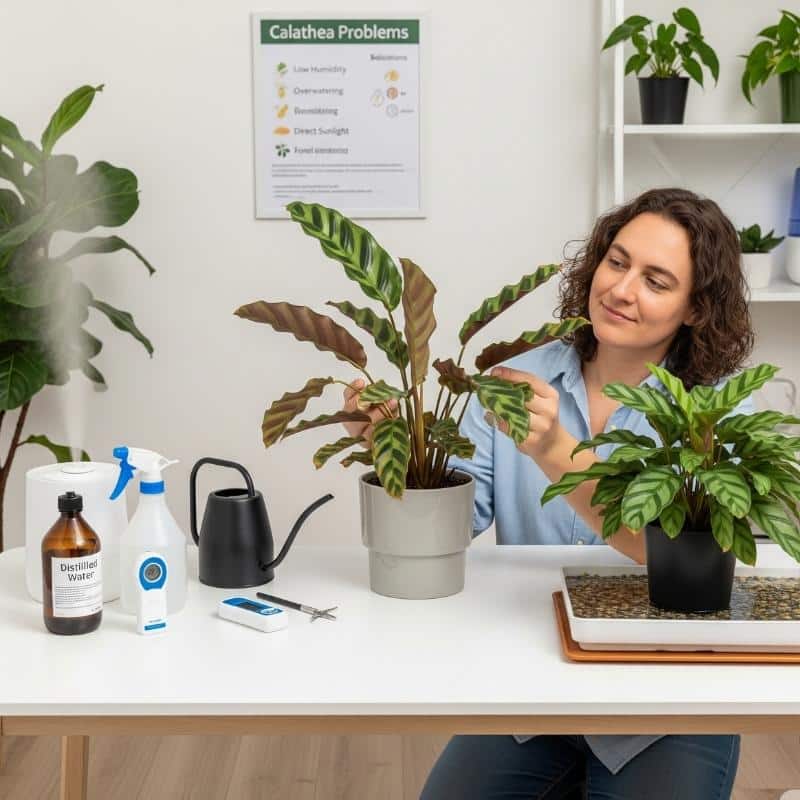
Common Calathea Plant Problems & Solutions
| Problem | What It Looks Like | Common Cause(s) | How to Fix |
| Brown/Crispy Edges/Tips | Leaf edges/tips dry, brown, crispy | LOW HUMIDITY (most common), Tap water minerals, inconsistent watering. | Increase humidity (humidifier is best!). ONLY use distilled/rainwater. Water consistently. |
| Yellowing Leaves | Leaves turn yellow, often lower ones | Overwatering (most common), soggy soil, root rot. | Let soil dry out more between waterings. Check drainage. If severe, repot, trim rotten roots. |
| Curling Leaves | Leaves curl inward, look shriveled | Very thirsty! (underwatering) OR very low humidity (drying out too fast). | Water thoroughly if soil is dry. Increase humidity drastically. |
| Fading Patterns/Dull Colors | Patterns look less vibrant, leaves mostly dull green | Not enough bright light. | Move to a brighter spot with indirect light. |
| No Leaf Movement (“Praying”) | Leaves stay flat, don’t fold at night | Stress (too little/much light, inconsistent watering/temp, low humidity). | Review all care conditions, aim for consistency. Provide ample bright, indirect light along with a high-humidity environment. |
| Pests | Tiny webs, sticky residue, small bugs (esp. spider mites) | General plant stress, low humidity (makes them very susceptible to spider mites). | Inspect regularly. Increase humidity (helps deter spider mites). Treat with insecticidal soap or neem oil. |
| Root Rot | Mushy stems at soil line, foul smell | Persistent overwatering | Prevent with proper watering & drainage. If severe, repot into fresh, dry soil after trimming any unhealthy roots. |
Is the Calathea Plant Toxic? Safety for Pets
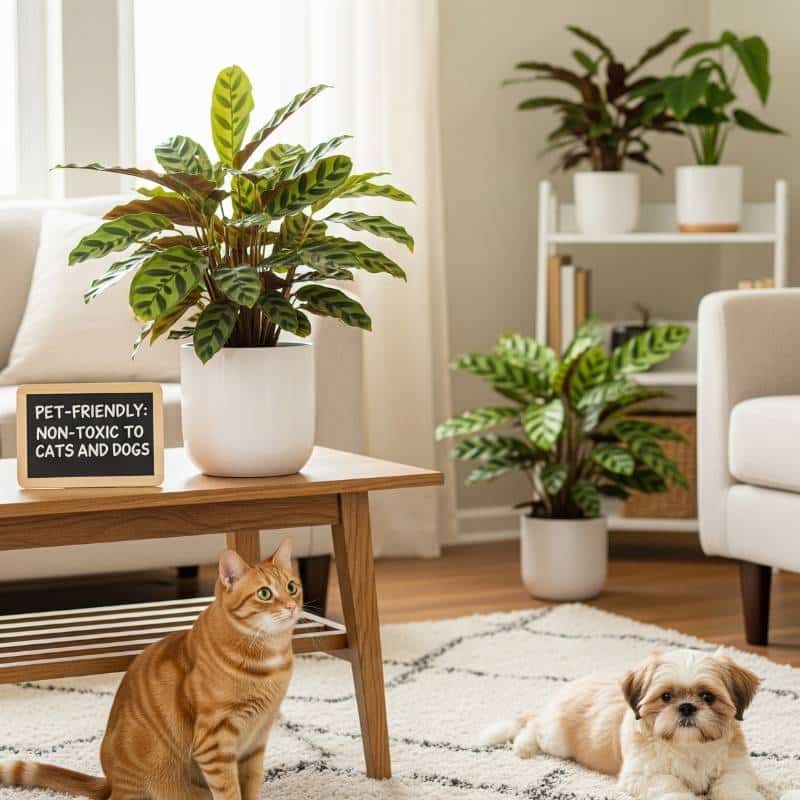
Good news for pet owners! The Calathea plant (Calathea species, including those now called Goeppertia) is generally considered non-toxic to cats, dogs, and other common household pets according to the ASPCA (American Society for the Prevention of Cruelty to Animals). Phew!
This makes it a relatively safe choice for households with curious furry friends who might occasionally take a nibble. While it’s considered non-toxic, it’s always wise to gently discourage pets from chewing on any houseplant, as ingesting a large amount of plant material could still cause a mild upset stomach. But you can generally feel at ease displaying this charming plant in your home with your pets around.
Calathea Plant for Home Decor: Living Art and Tropical Elegance
Calatheas are fantastic for home decor, bringing an unparalleled level of visual artistry and exotic elegance to any space!
Creating a Stunning Focal Point
With their bold patterns, vibrant colors, and unique leaf movement, a Calathea can instantly become the most captivating focal point in your home. It captures attention while introducing an element of refined drama and a hint of tropical charm.
💡 Great spot for an image! You could add a beautiful photo here showing a stunning Calathea as a centerpiece on a coffee table or a bright side table.
Perfect for Shelves, Tabletops, and Bathrooms
Their love for bright, indirect light and high humidity makes them ideal for brightening up shelves, tabletops, or even well-lit bathrooms where they can truly thrive in the steamy conditions.
Adding an Air of Exoticism and Movement
The unique patterns on their leaves, combined with their fascinating nightly “prayer” movement, give Calatheas an unmatched air of exoticism and life. They’re truly dynamic plants that engage and surprise.
💡 Great spot for an image! A photo here showing a Calathea with its leaves folded up at night, perhaps with a soft glow, would be excellent!
A Natural Air Purifier
Beyond their incredible beauty, Calatheas (part of the Marantaceae family, like Maranta) are generally considered good at helping to purify indoor air, contributing to a healthier and fresher living environment.
The Allure of Calathea Plant: Beautifully Challenging, Amazingly Rewarding
The Calathea plant truly stands out as a top choice for indoor gardeners who are ready for a delightful challenge. It offers an unbeatable blend of breathtaking, artistic foliage, fascinating leaf movement, and a vibrant burst of tropical elegance. While they have specific needs for high humidity and pure water, meeting these requirements is incredibly rewarding when you see their leaves unfurl perfectly and dance through the night. It’s more than just a plant; it’s a living, breathing piece of art that rewards your consistent care with unmatched beauty!
Frequently Asked Questions (FAQ) About Calathea Plant
Still have some questions about your wonderful Calathea? Here are some common ones that might help you out!
Q1: Why are my Calathea leaves getting crispy brown tips?
A1: This is the most common issue and almost always due to low humidity (they need a lot!) or minerals/chemicals in tap water.
- The Fix: Increase humidity with a humidifier. Watering should be done exclusively with distilled, rain, or filtered water.
Q2: How often should I water my Calathea?
A2: Water your Calathea when the top inch (about 2.5 cm) of soil feels slightly dry to the touch. They love consistent moisture but hate soggy feet! Always ensure your pot has excellent drainage. During the warmer months, you may find yourself watering more frequently.
Q3: Do Calatheas need high humidity?
A3: Yes, absolutely! VERY high humidity (60-80% is ideal) is crucial for Calatheas. This is their most important need for healthy, non-crispy leaves. Consider using a humidifier, placing the pot on a pebble tray, or clustering plants together.
Q4: Why aren’t my Calathea leaves moving at night?
A4: If your Calathea isn’t “praying” (folding its leaves up at night), it’s usually a sign of stress. This might result from inadequate or excessive light, irregular watering, improper temperatures, or extremely low humidity levels.Review all your care conditions for consistency.
Q5: What kind of water should I use for my Calathea?
A5: ONLY use distilled water, reverse osmosis (RO) water, or collected rainwater. Tap water (especially if it’s hard or chlorinated) will cause brown tips and can damage your plant over time.
Q6: Is the Calathea plant toxic to pets?
A6: No, Calathea plants are generally considered non-toxic to cats, dogs, and other common household pets by the ASPCA, making them a safe choice for homes with animals.
Q7: Why are my Calathea’s colors fading or looking dull?
A7: If your Calathea’s vibrant patterns are dulling or looking less intense, it’s usually a sign that it’s not getting enough bright, indirect light. The pigments need good light to develop.
- The Fix: Relocate it to a brighter area, while ensuring it stays out of direct sunlight!
Q8: Can Calatheas live in a low-light room?
A8: Calatheas prefer bright, indirect light. While they might survive in genuinely low light, their growth will slow significantly, and their beautiful leaf patterns might become dull or even disappear. They won’t thrive.
Q9: What’s the best way to clean Calathea leaves?
A9: To keep their leaves looking their best, gently wipe them down every few weeks with a soft, damp cloth (using distilled or filtered water). Avoid using leaf shine products. This helps them absorb light better and keeps them looking vibrant.

